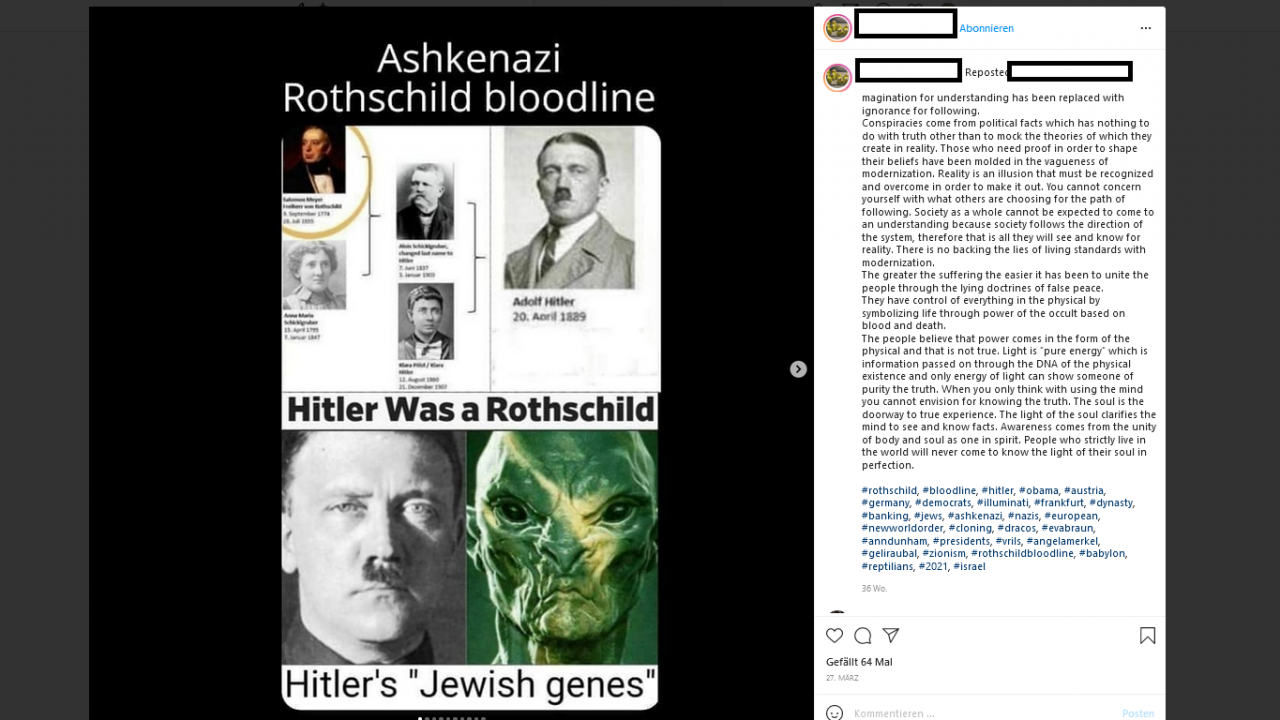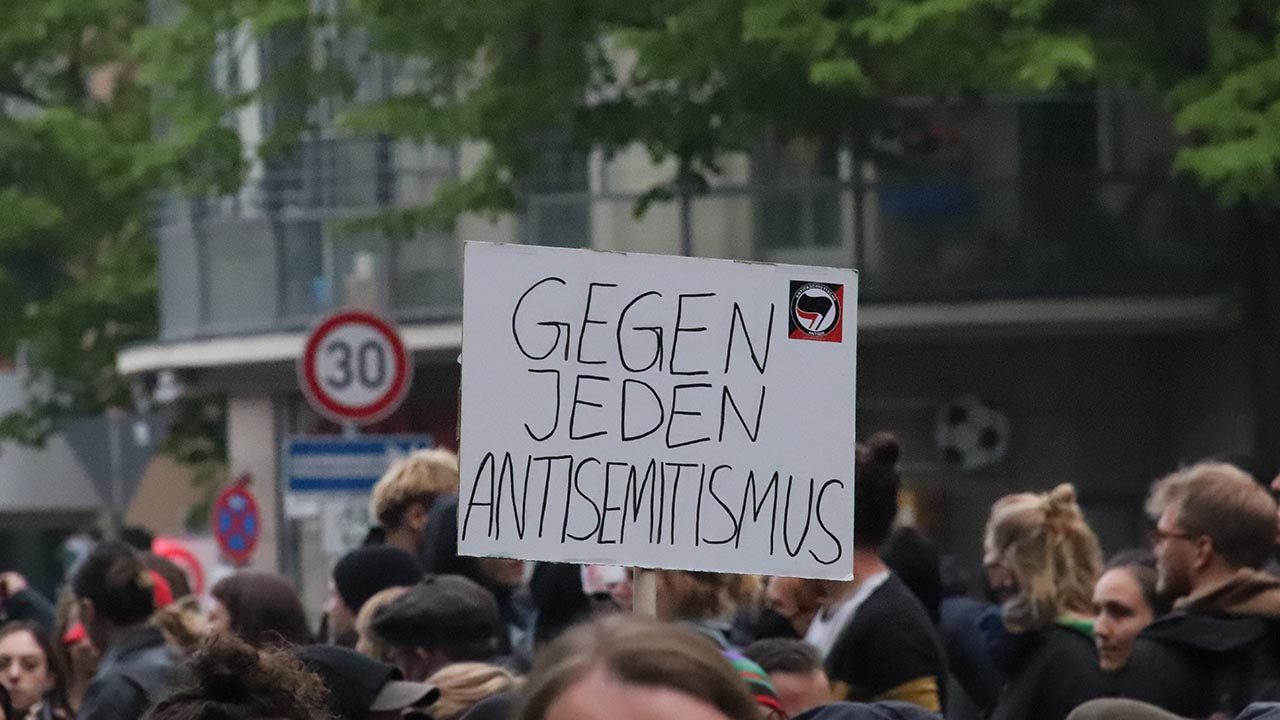
The following text is an excerpt from „Anti-Semitism in the Digital Age: Anti-Semitic Hatred, Holocaust Denial, Conspiracy Ideologies and Terrorism in Europe“ by Amadeu Antonio Foundation (Germany), Hope not Hate (UK) and Expo (Sweden), published in October 2021.
Founded in 2010 and swiftly purchased by Facebook (today: Meta) in 2012, Instagram has an estimated 1.1 billion active users worldwide, making it by far the most popular dedicated photo sharing platform and the fourth most popular social media platform overall, surpassed only by Facebook, YouTube and Whatsapp.124 In Europe, Instagram has an estimated 284 million users.
Instagram’s user base is significantly younger than that of Facebook and Twitter, with almost 70% of their global users aged between 13-34,125 while a survey by the Global Web Index found Instagram is the most popular platform among men and women aged 16-24 and among women aged 24-35. The platform is fundamentally mainstream in terms of the most popular content, with popular celebrities and athletes garnering huge followings on the platform, as well as thriving beauty, fashion and wellness communities that centre around popular influencers who develop their celebrity brands on the platform itself.
However, like every other social media platform, Instagram has struggled to prevent the platform’s misuse to spread hate, misinformation and conspiracy theories. While much of the criticism levelled at Instagram centres around its perceived role in promoting unhealthy body image and insecurities among its young, image-conscious user base, it has also been accused of failing to act on incitement to hatred and even terrorist recruitment that takes place on the platform.
Instagram’s Features
Instagram was set up primarily as a way to share photos, with the ability to share short video clips being added in 2013. Users are able to write lengthy captions of up to 2,200 characters to their posts, but the format is still very much image-led, with the captions largely concealed as users scroll down their homescreens. Alongside standard photo and video sharing, Instagram also offers the ability to upload time-limited Stories, which self-delete after 24 hours, and stream live onto the platform. The Instagram Direct feature also allows users to send private messages and share posts with other users. The two primary means by which users can discover new content on the platform are the use of hashtags and the Explore tab, a section of the site which presents users with algorithmic content recommendations. Users are encouraged to put descriptive hashtags in the captions of their posts, which allow users to search for
content relevant to their interests. Instagram is able to disable hashtags so that they cannot be searched for and do not link to content when clicked upon, which they have done for certain well-known far-right and antisemitic jargon terms such as #HoloHoax and #14Words. However, this has not been applied with any rigour, and hashtags such as #BloodAndSoil or #WhiteGenocide still lead to thousands of results from far-right accounts.
The Explore tab is more complex in function, and has been the subject of considerable criticism for its role in promoting hateful and harmful content. It aims to present users with a tailored feed of new content from accounts that they do not follow based on their previous activity on the site, such as the accounts they follow already and posts they have liked or commented on.
Similarly, the ‘Suggested for you’ sidebar offers a list of accounts to consider following, again based on previous activity on the site. While this functionality might be useful for many of Instagram’s users, (e.g. for connecting a sports enthusiast with content related to their favourite teams), it can also play a disturbing role in guiding users down a rabbithole of political extremism. Users whose activity indicates an openness to one aspect of far-right ideology or bigotry can find themselves being recommended a stream of content from accounts that reinforce that viewpoint and introduce the user to new and potentially more extreme strands of hateful ideology. It can also introduce people to far right content for the first time, if their non-political interests happen to overlap with those of far-right users.
Conspiratorial antisemitism
In August 2020, Facebook and Instagram announced that they had updated their Community Standards guidelines to include a Tier 1 prohibition (representing the most serious violation of guidelines) of allegations of “Jewish people running the world or controlling major institutions such as media networks, the economy or the government”. Despite this, it is still easy to find antisemitic conspiracy content on the platform, even when it is clearly labelled as such by accompanying hashtags.
As an image-led platform, Instagram is well suited to host conspiracy material. Online conspiracy theorists on all social media platforms often rely on the use of lurid imagery and complex misinfographics to illustrate convoluted conspiratorial narratives. In the case of antisemitic material, such posts often consist of diagrams purporting to reveal secret power structures in which Jewish individuals or families exert control over governments, economies and religious institutions.
The huge quantity of conspiracy material present on Instagram can be seen clearly in hashtags such as #Illuminati and #NWO, both of which refer to a genre of conspiracy beliefs which describe a global shadow government which secretly controls all global events. There are millions of results for these and closely related hashtags, of which a minority are satirical but a clear majority are in sincere promotion of
these conspiracy theories. The Illuminati and New World Order conspiracy theories are often strongly influenced by antisemitic tropes, whether implicitly or explicitly, and anyone who is drawn into researching these topics online is highly likely to encounter antisemitic content on a regular basis, making their high prevalence on Instagram a worrying phenomenon whether the specific posts contain antisemitic content or not Hashtags that lead more directly to antisemitic content have fewer but still worrying numbers of posts, and remain active despite Instagram’s ability to block the use of hashtags that lead to prohibited content. Hashtags that directly refer to antisemitic conspiracy jargon such as #JewWorldOrder, #TheGoyimKnow and #ProtocolsofZion lead to thousands of posts, many of which are either explicitly antisemitic in content or have been posted by accounts that commonly post on those lines.
A number of well-known antisemitic conspiracy theorist accounts remain on Instagram, many of whom have retained a presence on Instagram despite being removed from most other major platforms, including Instagram’s parent company Facebook. The prominent British conspiracy theorist David Icke, among the most famous conspiracy theorists in the world, has retained his Instagram account as his last mainstream social media platform, boasting 243,000 followers. Also present on the platform is antisemitic author E. Michael Jones, who has been suspended from Twitter and YouTube for his persistent promotion of antisemitic conspiracy theories, as well as having some of his books removed from sale by Amazon. Both Icke and Jones’ accounts are relatively inactive in recent months and the content they do post is much less controversial than that on other platforms, perhaps in an effort to prevent their removal, but both use them to signpost their activities elsewhere and thus contribute to the promotion of their antisemitic ideologies.
Israel-related antisemitism
Instagram also plays host to forms of antisemitism that are framed as anti-Zionism and hostility to Israel. This was particularly when conflict flares in the Middle East, such as in May 2021, when an outbreak of violence prompted a spike in the use antisemitic rhetoric and hashtags on the platform. There are more than 11,300 posts tagged with either #DeathToIsrael or #Death_to_Israel, thought it should be noted that users sometimes appropriate hashtags that they disagree with in order to provide a counter-narrative in that conversation.
On 11 and 16 May, two Arabic language accounts gained a combined 15,000 likes for posts captioned with the slogan “Khaybar, Khaybar, O Jews, the army of Muhammad will return”, a chant which refers to a 7th century battle between the early Muslim community and Jewish tribes in the Arabian peninsula and thus frames the current conflict into the context of a wider historical animosity towards the Jewish people. On 17 May, a post from the Iraqi Shi’ite scholar Ali al-Toqani, who has over five million followers on the platform, threatened the destruction of the State of Israel, saying “I swear that the demise of Israel will be at the hands of an Iraqi, no matter how long the years take”,130 a sentiment which attracted more than 92,000 likes.
Extreme right
Most worrying, particularly in light of Instagram’s younger user base, is the use of Instagram for recruitment by the extreme right. Investigations by Patrik Hermansson of HOPE not hate have revealed the existence of two separate terror groups using Instagram as their primary means of propagandising and recruitment, both of which were run by teenagers and used the platform to target young people with deeply antisemitic propaganda imagery and expressions of violent racial hatred.
The British Hand131 group and National Partisan Movement (NPM)132 both used Telegram, the unmoderated and privacy-focussed messaging app, for what they hoped were private conversations between group members. However, their outreach and recruitment took place on Instagram, where they benefited from the algorithmic recommendations of the Discover tab. Instagram users who followed the account of one group member would soon be recommended the main group page, and initial conversations with new recruits would be had over Instagram messenger before moving over to Telegram. A member of the British Hand group described Instagram as their “luckiest area”, while a senior figure in NPM described it as their “primary way” of recruiting new members.
On a post from their now-deleted account dedicated to recruitment, the NPM declared their intention to “secure white identity in Europe”, but used hashtags intended to draw in a wide range of more mainstream right-wing users, such as #conservative, #patriotism and #republicans, alongside more accurate descriptors such as #NationalSocialist. These efforts to radicalise mainstream users and inser their narratives into wider conversations illustrate the danger that is presented by any extreme right presence on mainstream platforms, particularly in light of Instagram’s popularity among the youngest internet users.
This text ist an excerpt and can be read with illustrations and footnotes in:
Antisemitism in the Digital Age
Online Antisemitic Hate, Holocaust Denial, Conspiracy Ideologies and Terrorism in Europe
A Collaborative Research Report by Amadeu Antonio Foundation, Expo Foundation and HOPE not hate
2021
Contents:
- Executive Summary
- The Report in Numbers
- Introduction
- Conspiracy Ideologies, COVID-19 and Antisemitism
- Superconspiracies: QAnon and the New World Order
- Case study: Path of radicalisation into antisemitism
- The Changing Nature of Holocaust Denial in the Digital Age
- Case Studies of Antisemitism on Social Media:
- Parler
- Telegram
- TikTok
- YouTube
- “4chan /pol/”
- Glossary of Antisemitic Terms
- Learnings from Project
Download the report as a PDF here:



